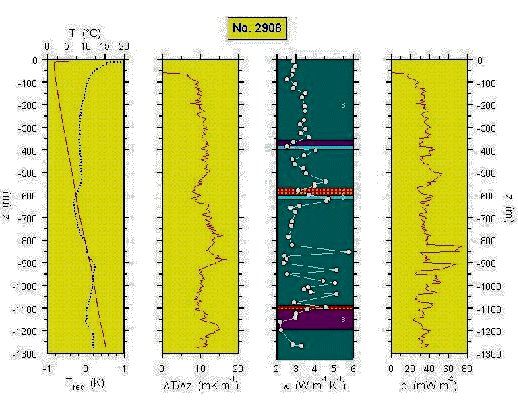Strukturelle, advektive und paläoklimatische
Einflüsse auf den Wärmetransport in der kristallinen Oberkruste
am Beispiel der Kola-Halbinsel (Russland)
Heat transfer processes in the upper crust - a detailed
geothermal and hydrogeological study in the area of the Kola deep
borehole, Russia.
an international research project involving various
partners from Finnland, France,
Germany, and Russsia
Permission for field work and access
to data archives was kindly granted by the Nikel-Pechenga Geological
Expedition, Nikel, Murmansk Oblast, Russia
Contact: Christoph
Clauser, Ilmo
Kukkonen
Content:
Main
results:
In a 3 km x 5 km area in the immediate vicinity of
the Kola deep borehole SG-3, existing and accessible boreholes of up
to 2000 m depth were used to generate a high-quality geothermal data
set:
- 14 new digital temperature logs were recorded in a
field campaign in summer 1994
- 22 records of previous analog logs were digitized
- data on inclination was obtained for 27 boreholes
from existing files
- 1.5 tons of core from 23 of the 36 boreholes were
selected and shipped to Hannover
- thermal conductivity was determined by Yuri
Popov on 769 core samples in 1996
- based on this data, composite logs were determined
for a total of 19 boreholes
Current
research activities:
3-D
Modeling of the investigation area for simulations of transient and
steady-state fluid flow and heat transfer in order to find answers to
the following questions:
-
How
does advective heat transfer by ground water flow influence the
total heat transfer?
-
What
is the effect of the spatial heterogeneity and the thermo-physical
rock properties on the temperature field in the bedrock?
-
To
what degree is it possible to reconstruct the paleoclimatic
temperature variations on the Earth´s surface from their signatures
in the temperature field of the upper crust?
The following groups and individuals contributed actively
to this first phase of the project:
- Svet Milanovsky,
Leonid Borevsky, Vladimir Morgachov (Russia)
- Ilmo Kukkonen
(Finland)Y
- Christoph
Clauser, Hans-Walter Fesche, Rüdiger Schellschmidt (Germany)
Additionally, operational support was provided by Guy
Vasseur (France), Hans
Burkhardt (Germany), and the Geoforschungszentrum
Potsdam
Participants
in the current phase of the project (3-D Modeling):
-
Christoph
Clauser,
Darius
Mottaghy (Germany)
-
Ilmo Kukkonen (Finland)
-
Yuri Popov (Russia)
Kola region around the cities of Nikel and Zapolyarny in north-west
Russia.
|
Detailed study area between Nikel and Zapolyarny.
The Kola deep hole SG-3 is in the lower left corner of the detailed
study area.
|

Temperature profiles of one of boreholes logged in this project.
Reduced temperature is determined using
a constant temperature gradient of 12 mK m-1 and
a mean annual ground surface temperature of 1 °C.
Thermal conductivity was measured by Yuri Popov with his optical
scanning device.
|
back to CONTENT
Project
and funding status:
- Initial funding by the European Union (INTAS-93-273)
and the German Science Foundation (Cl 121/4-1).
- Continued funding granted by the European Union
(INTAS-93-273-Ext) and from the German Science Foundation
(Cl 121/4-2):
- Continued funding granted by the German Science Foundation (Cl 121/4-3)
German
abstract
of current funding
project:
back to CONTENT
First
results of a numerical pilot study published in: Kukkonen,
I. T., & Clauser, C., 1994. Simulation of Heat Transfer at the
Kola Deep-Hole Site - Implications for Advection, Heat Refraction
and Palaeoclimatic Effects. Geophys. J. Int., 116(2): 409-420.
abstract

